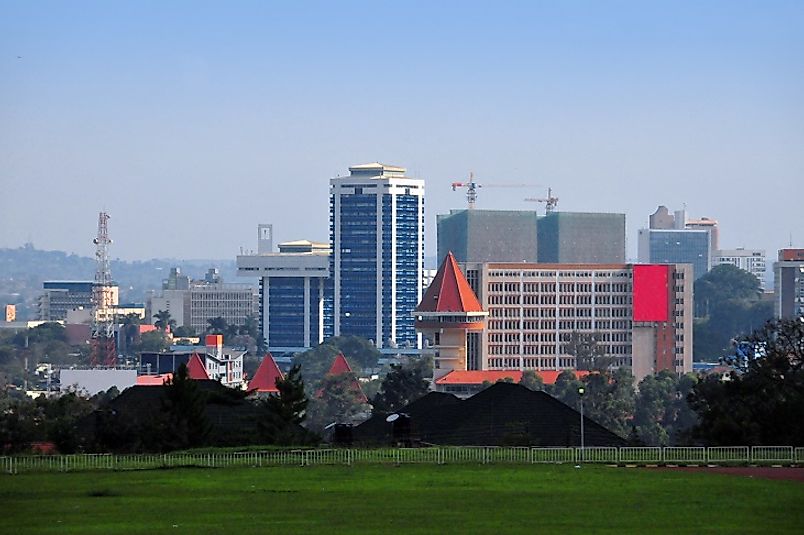Biggest Cities In Uganda

Uganda is a country in the East Africa, located between the eastern regions of Kenya and the western parts of the Democratic Republic of the Congo. It borders five countries in total, including Kenya, Rwanda, Tanzania, South Sudan, and Democratic Republic of Congo. Uganda's capital city of Kampala is also by far the largest town in the country. The city is both the capital of Uganda and the backbone to the country’s economy. Despite the city dynamic and engaging activities, the growth and development is at snail’s pace and employment opportunities in the city are dwindling, so are the living conditions. In contrast to such other major cities in Africa as Nairobi and Lagos, Ugandan cities are not sprawled or overpopulated. The rate of crime is low, and the cities are way safer. The towns have a fast growing economy and are expected to grow into commercial hubs and fringes to "delocalize" and decentralize the already overcrowding Kampala.
Kampala
Kampala has a population of around 1,659,600 as of the mid-year count taken in 2011. The city has a diverse ethnic population. The largest ethnic groups are Baganda, Banyankole, Basoga, Batoro, Bakiga, Bafumbira, Alur, Iteso, Langi, Acholi, and Banyoro. Most people in Kampala are born in the city but identify with their cultural roots. The Banyankole migrated from western Uganda to Kampala when Yoweri Museveni became president. Tribal intermarriages outside the city are still uncommon, and people usually speak their cultural language alongside Luganda, English, and Kiswahili. The major contributors to the economy of Uganda are the 25 commercial banks licensed by the government, Crown Beverages Limited, the Daily Monitor publication which is part of the Kenyan based Nation-Media Group, and Air Uganda. There are efforts to relocate heavy industries to the Kampala Business and Industrial Park in Namanve approximately 14 kilometers east of the central business district. The Entebbe International Airport serves the city of Kampala.
Nansana
Nansana, located in the Central region of Uganda along the main highway of Kampala-Hoima, is 13 kilometers northwest of Kampala. As of 2014, the city's population stood at 365,857. The town serves as dormitory town to the City of Kampala. Due to its proximity to Kampala, many workers in the city live in Nansana and commute to the city daily to work. As such the economy of Nansana largely depends on that of Kampala. There are plans to transform the town into a commercial hub for the businesses that mushroom at night are hardly taxed by the government because the city provides no tangible revenue to the government. The transformations targeted are the introduction of banking institutions, removal of bureaucratic barriers to foreign investment, increase employment to the locals, commercialization of Agriculture and improving transport. So far, small informal markets such as home-based businesses, kiosks, bars, and car washing bays dominate the economy.
Kira Town
Kira Town, located in the Wasiko District of central Uganda, lies approximately 14 kilometers to the northeast of Kampala. The city borders Gayaza to the north, Kampala to the west, Lake Victoria to the south, and Kasangati to the northwest. The town is the second largest urban center of Uganda after Kampala. It has a population of 313,761 according to the August 2014 census, making it the 3rd most populous city in Uganda. The town’s proximity to the capital has facilitated the city’s growth. People commute to Kampala for work and return in the evening. The younger generation engaged in the boda-boda (motorcycle taxi) industry. However, the region has a capacity for growth since the Kampala Industrial and Business Park is at the southeastern end of Kira Town. The park will serve as a city fringe of Kampala for industrial relocation. The town is home to the Kabaka Palace located in Kireka, Mandela National Stadium in Bweyogerere Ward, and the Basilica of the Ugandan Martyrs in Namugongo. The Kampala Northern Bypass Highway, the first dual carriage interstate highway in Uganda serves the city. Even though the road forms an incomplete transport circle, it still services the north, northeast, and northwest of Kampala city. The Umeme Electricity Substation constructed in 2015 has stabilized power in the fast growing urban area. The Public Health department of the town focuses on improving the living conditions of the city through improved sanitation, provision of safe drinking water and more secure garbage and waste disposal.
Mbarara
Mbarara Town in Western Region of Uganda is the capital, the main administrative and commercial center of Mbarara District. Located 290 kilometers southwest of Kampala, the town is a crucial transportation hub lying along the road to Kabale from Masaka. It is also the largest industrial town second only to Kampala, and it is the fastest growing city in the country. The city boasts of modern buildings including malls, villas, and arcades, and hotels, hospitals such as the Mbarara Hospital and Mayanja Memorial Hospital. The city is home to the Mbarara University of Science and Technology. The Bank of Uganda and the National Social Security Fund has branches in Mbarara. The Mbarara Bypass Road is set to serve the town and its suburbs and divert trucks and goods in transit to Rwanda, Burundi and the Democratic Republic of the Congo from the city's center. Principal industries in the city include Mbarara Brewery and Mbarara Steel Plant. The Mbarara Airport located 10 kilometers northwest of the city. In August 2014, the Uganda Bureau of Statistics estimated the town’s population as 195,013.
An Alluring Nation
Uganda is a beautiful country, and its towns, people, and climate are inviting. The country has two rainy seasons, and the climate is stable thanks to its location near the equator. The rainforests of Uganda have transformed the country to a green African state, and even recent urbanization or civilization has not changed the Ugandan culture.
The Biggest Cities In Uganda
| Rank | Biggest Cities in Uganda | Population |
|---|---|---|
| 1 | Kampala | 1,659,600 |
| 2 | Nansana | 365,857 |
| 3 | Kira Town | 313,761 |
| 4 | Mbarara | 195,013 |
| 5 | Mukono Town | 161,996 |
| 6 | Gulu | 152,276 |
| 7 | Masaka | 103,829 |
| 8 | Kasese | 101,679 |
| 9 | Hoima | 100,625 |
| 10 | Lira | 99,059 |







